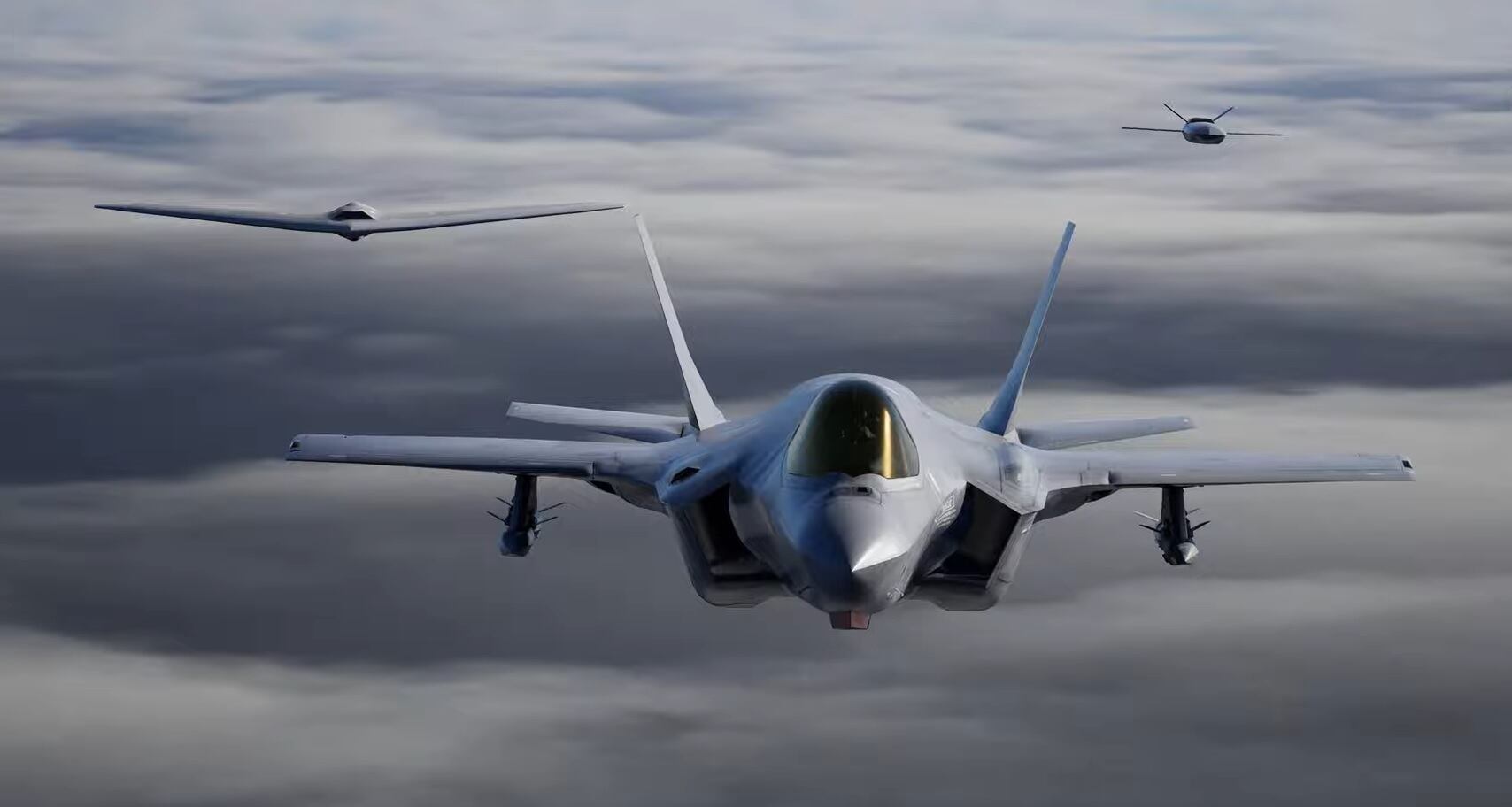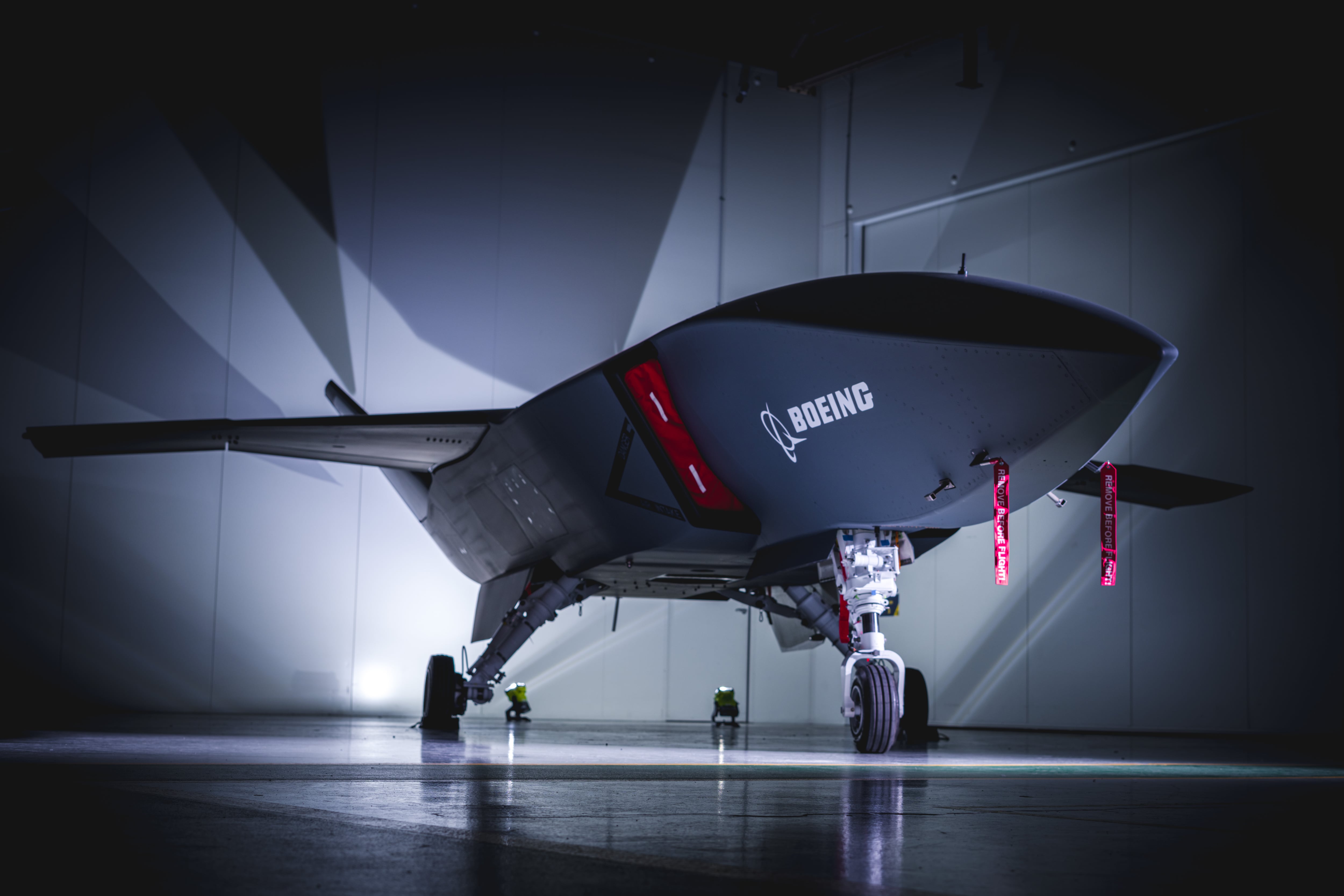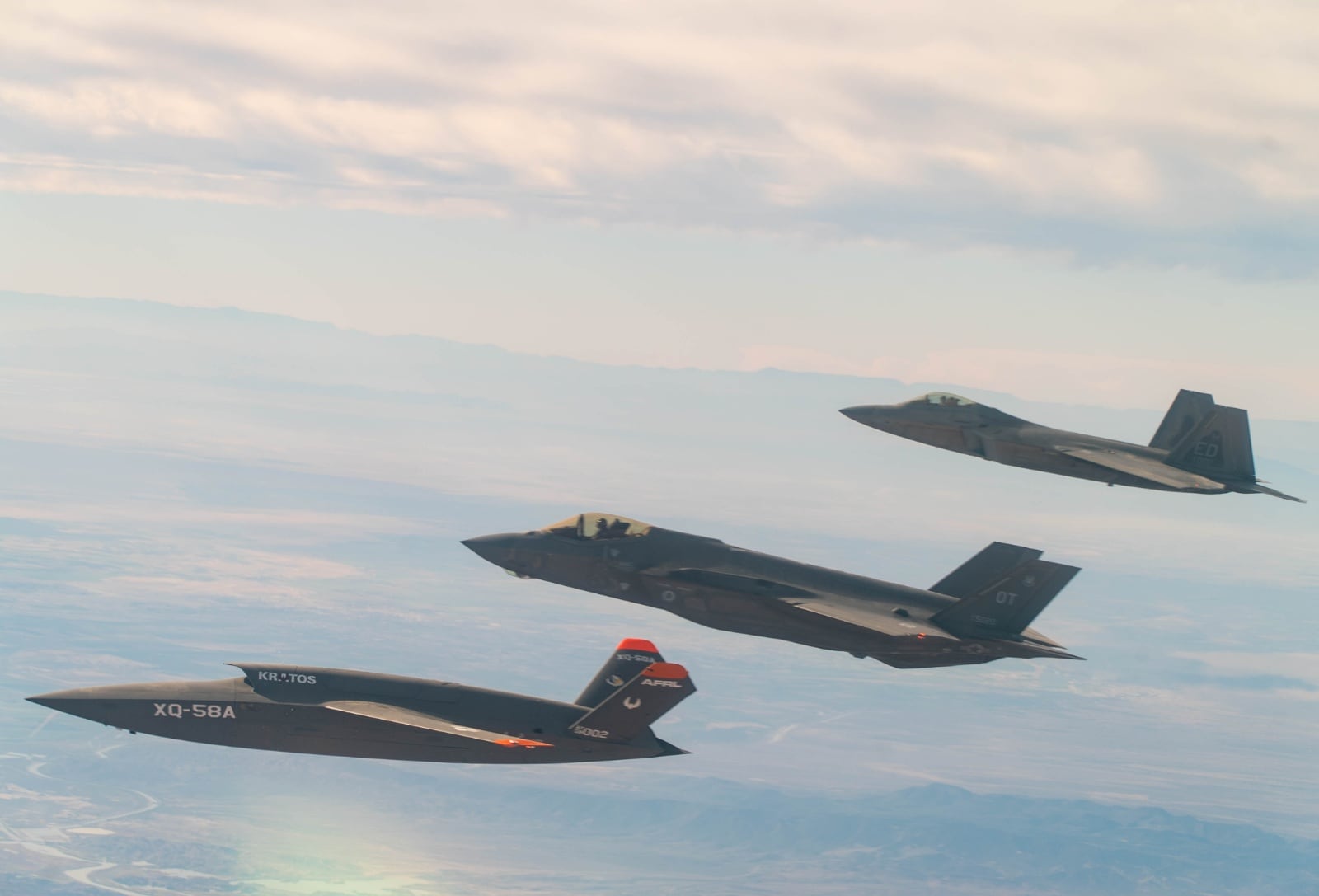FARNBOROUGH, England — The future of defense aviation is autonomous, aerospace industry leaders repeatedly said at twin air shows in England this month — and it’s arriving soon.
U.S. Air Force Secretary Frank Kendall has made it a top priority for the service to increasingly use autonomous aircraft — that is, an unmanned aerial vehicle, or UAV, that uses technology like artificial intelligence to manage its missions.
And at the back-to-back Royal International Air Tattoo and Farnborough Airshow, time and again the topic of autonomy came up in conversations, interviews and briefings, as company executives sought to show how they could make it a reality.
Industry leaders see autonomous aircraft and teaming capabilities as a key market set to rapidly grow — as well as an avenue to accelerate research and development into cutting-edge new technology and build partnerships with other organizations.
“This is a really exciting time to be in aeronautics,” Tom Jones, president of Northrop Grumman Aeronautics Systems, said in an interview with Defense News at RIAT July 16. “There’s a lot of things changing, and the threat is pushing us to look at technologies that we haven’t before.”
A prime example of these new technologies is using unmanned aircraft to augment fighters on combat missions. The Air Force is starting to refer to these as collaborative combat aircraft, or CCA, and wants them to accompany F-35s and the secretive sixth-generation Next Generation Air Dominance platform now in the works.
With Air Force officials increasingly worried about the potential for a war to erupt with China — whose modernized military and air defenses could pose a major threat to allied aircraft — Kendall wants the service to augment its fighters with autonomous drones that could serve as decoys or scouts or even jam enemy signals or conduct their own strikes.
Kendall earlier this year numbered this concept among his seven “operational imperatives” for the department to pursue.
And at Farnborough and RIAT, the conversation focused on the finer points of how such a manned-unmanned teaming concept would become reality — and how to avoid potential pitfalls.
Firms hone their pitches
In a briefing for reporters at Farnborough, Steve Nordlund, vice president and general manager of Phantom Works for Boeing Defense, Space and Security, said manned-unmanned teaming doesn’t have to be a “swarm” of UAVs around one piloted fighter — although he said Boeing could produce swarming technology if needed.
Instead, Nordlund said that Phantom Works — Boeing’s research and development organization — envisions these autonomous drone wingmen possibly being “untethered” from a platform and able to go where they are most needed.
If a fighter pilot flying a mission has a need for a particular capability — for example, if he comes across a pocket of enemy air defenses that need to be shut down — he could call upon one of an array of autonomous drones lurking nearby to electronically jam or otherwise neutralize those air defenses. And the other fighters flying the mission could turn to the same reserve of nearby drones if they need help.
This would differ slightly from the concept Kendall has described, in which an F-35 or Next Generation Air Dominance fighter would be “calling plays” for its own unique formation of as many as five unmanned aircraft dedicated to that fighter.
“If there’s an aircraft in a different vicinity that has a need, the unmanned system could respond to that,” Nordlund said. “So the interoperability piece becomes really important, the level of autonomy becomes important. How that handoff happens is really important. So those are a lot of the things that we’re working on, both procedurally as well as the technology to enable it.”
Nordlund said Boeing could also produce autonomous wingmen that operate “tethered” to a single aircraft if necessary, adding that the company wants to be flexible enough to provide both options.
Northrop’s Jones warned that to quickly field a system that can team autonomous drones with piloted aircraft, the Air Force and industry must simplify the missions they want them to do — in other words, walk before they can run.
“We can’t make everything too complex out of the gate,” Jones said. “Let’s not make an unmanned F-35 the first step. If you try … it’s going to be a long time to get there.”
Jones said that means identifying whether the Air Force wants a fighter’s autonomous teammate to be a “missile truck” to augment its firepower, for example, or to carry a separate system of radars or sensors to provide a better picture of the battlefield. And it could mean having multiple unmanned systems that could each do its own unique job, he said.

Defense firms — from smaller companies to some of the largest contractors — are hoping to take advantage of momentum in this field.
Before RIAT and Farnborough began, Lockheed Martin’s Skunk Works said in a briefing with reporters it was working on a mix of expendable drone wingmen — which it said could be fielded in as soon as three years — and more advanced autonomous systems for the Air Force.
Autonomy goes mainstream
And at Farnborough, Kratos Defense and Security Solutions touted recent test flights of two of its autonomous XQ-58A Valkyrie drones as part of the Skyborg artificial intelligence wingman program — and said the success could lead to mainstreaming such autonomous technology.
Kratos executive Jeffrey Herro even predicted Skyborg could be wound down within the next year or so, and the capabilities it has demonstrated incorporated into new systems.
“This is getting to the end of the Skyborg program, is where we are,” Herro said in a July 18 interview with Defense News. “And then it will morph into other programs.”
Boeing Defense officials pointed to work they’ve already done in manned-unmanned teaming on already-established platforms such as the MQ-28 Ghost Bat — also known as ATS, or Airpower Teaming System, or more popularly, the Loyal Wingman program demonstrated by the Royal Australian Air Force. Boeing also makes the MQ-25 Stingray, the Navy’s autonomous refueling drone.
Ted Colbert, the chief executive of Boeing Defense, Space and Security, said company officials spent days at RIAT talking to customers about autonomous, uncrewed teaming. There is tremendous interest around this market, he said, and it will be important in coming years.
“We’re leaning really hard into the future with autonomy [and] ATS,” Colbert said in a roundtable with reporters in London July 17. Those programs “offer the opportunity to leverage all the lessons on … moving [traditional] physical platforms forward, but also integrating great technology from a connectivity, analytics, artificial intelligence perspective, and those supporting the needs of our missions around the world, as they evolve.”
Colbert said Boeing is also energized by the fact the uncrewed teaming concept is “brand agnostic” and not just a Boeing-specific program.
Boeing has a its own engineering, research and development and autonomous technology expertise, Colbert said, but the company will partner with other organizations when it can.
“I come from the technology world, and the way you win in the technology world is through partnerships,” Colbert said. “You find other folks that can complement the great capabilities that you have, you combine them and you move forward.”

Autonomy also emerged as a possible selling point as two key companies jockeyed for position in a potential Air Force aerial refueling tanker program.
Airbus on July 19 announced its A330 Multi Role Tanker Transport — the basis for the Lockheed Martin LMXT aerial refueling tanker it hopes can compete for the service’s KC-Y bridge tanker — had been certified to conduct automatic air-to-air refueling boom operations in daylight, and is the first ever tanker to receive this certification.
Airbus also said it had launched a demonstrator it hoped would produce technologies that could lead the way to autonomous refueling and formation flights.
Boeing, which makes the KC-46A Pegasus tanker the Air Force is now bringing into service, later that day issued a statement to reporters saying the Pegasus had carried out autonomous boom aerial capabilities during flight tests. The Air Force is considering forgoing a competition for the bridge tanker and going straight to buying more KC-46s, though Lockheed hopes it has a chance to compete.
And it wasn’t just aviation firms eyeing the autonomous market. Companies that make technologies that feed into autonomous systems also sought to demonstrate their work.
In a July 18 interview with Defense News at Farnborough, William Lynn, who leads Leonardo DRS, said integrated sensing capabilities, which his company makes, are at the core of autonomy, although his company is primarily working with the Army on the technology. If sensors bring in a jumble of data and signals that can’t be combined in a cohesive, integrated way, he said, the unmanned vehicle won’t be able to operate reliably.
“To be able to have autonomy, you need to have that whole 360 degree view of the world and the ability to process that in an integrated way ... to let tanks [or] any kind of land vehicle operate autonomously,” Lynn said. “It’s going to have to be able to see its world, understand the terrain, understand where friendly forces are, where adversary forces are. You can’t drive the tank if it’s all coming in in a fragmented way.”
Leonardo DRS is a mid-tier defense electronics firm that primarily serves the U.S. military, and is the U.S. subsidiary of the Italian defense firm Leonardo SpA.
And the autonomy concept has moved so far along that discussions have increasingly shifted to operational questions — for instance, how pilots would manage their drone wingmen in a combat situation.
Air Commodore Jim Beck, an F-35 pilot for the U.K.’s Royal Air Force, said at a panel discussion at Farnborough July 19 that adding UAV wingmen likely won’t tax pilots’ attentions while flying in combat, since the fighter already automatically processes mammoth amounts of information without the pilot’s input.
“There is no reason why [a drone wingman] should be any less autonomous than what the F-35 is doing right now,” Beck said. “We can design the architecture such that ... we don’t saturate the human [with] decisions. ... We’re there pretty much already with the F-35.”
Stephen Losey is the air warfare reporter for Defense News. He previously covered leadership and personnel issues at Air Force Times, and the Pentagon, special operations and air warfare at Military.com. He has traveled to the Middle East to cover U.S. Air Force operations.








